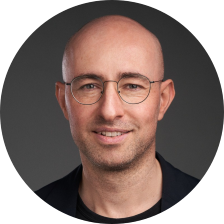Meet the Artist
Alexander Peterhaensel's artistic practice reflects contemporary and future questions of computer-mediated realities, implications of machine intelligence and machine agency and the future of Human-Machine-Interaction – for example in interactive media architectures in VR and AR. Since 2014, he teaches Moving Image and Digital Production Processes at the Institute for Time Based Media at the University of the Arts Berlin as an Assistant Professor.
Resonances III Project
Resonance Space: Immersive Big Data Experience
Alexander's installation Resonance Space: Immersive Big Data Experience, consisted of an Augmented Reality/immersive installation on the topic of global warming. He created a responsive audiovisual environment: a resonant space which reacts to the presence of the user/visitor. The virtual environment, based on Big Data sets of global weather data, metaphorically and factually representing our world climate, will be thrown out of balance by the presence of the visitors. The more the visitors move around in the installation, or the more energy they emit, the more the environment will be thrown out of balance. The installation will then try to balance itself out in a co-active dialogue with the interfering visitors, reflecting their activatedness and energy level. A calmer behaviour of the visitors leads to a calmer reaction of the environment.

A collaboration between Alexander Peterhaensel, Daniel Tirelli, Jutta Thielen-del Pozo and Thomas Petroliagkis
Art & Science and the New European Bauhaus Position Paper (continued collaboration with JRC)
Alexander was one of the contributors and editors to the position paper resulting from the collective brainstorm of artists (including Roberto), experts and JRC SciArt, which was published as an article on the journal Noema, wanting to illustrate the benefits that art and science can bring to the New European Bauhaus. This work attempts to showcase some of the small but important practical and theoretical differences that a creative dialogue between science and art and a cross-disciplinary culture can bring along. It has been signed by distinguished art&science practitioners internationally.
As practitioners of SciArt we think that the NEB creates the opportunity to push these practices from niche to public field, thrusting SciArt beyond its conventional spaces (be it a lab, studio, exhibition or performance)... SciArt practitioners have hands-on experience in implementing artistic projects within scientific set-ups and vice-versa, often relating to a diversity of stakeholders, provoking new perspectives on exploration, introspection and behaviour – fostering meaning, emotions and values – both on an individual and societal scale.
Check it out at: Art|Science and the New European Bauhaus. Publioshed by NOEMA – Technology & Society (noemalab.eu)
VR experience @ JRC Ispra (Nov 2021) (continued collaboration with JRC)
Sensing the potential impacts of global warming
Resonances III artist Professor Alexander Peterhaensel returned to the JRC Ispra site on 12/11/2021, having been contracted to develop a VR demonstrator for visualising data in 3D. The installation visualises a time series of 1-year global daily temperatures, allowing participants to manipulate and step into the virtual space. It employs global weather data to visualise the potential impacts of global warming.
Colleagues on the JRC Ispra site were invited to test this installation, on the afternoons of Thursday 11 November and Friday 12 November, and were able to meet and discuss with Alexander. The tests will be preceded by presentations on the work (14:00 Thursday 11 November and 14:00 Friday 12 November).
This work is based on Peterhaensel's VR installation Resonance Space: Immersive Big Data Experience, produced for Resonances III, datami, in collaboration with Daniel Tirelli, Jutta Thielen-del Pozo and Thomas Petroliagkis.

